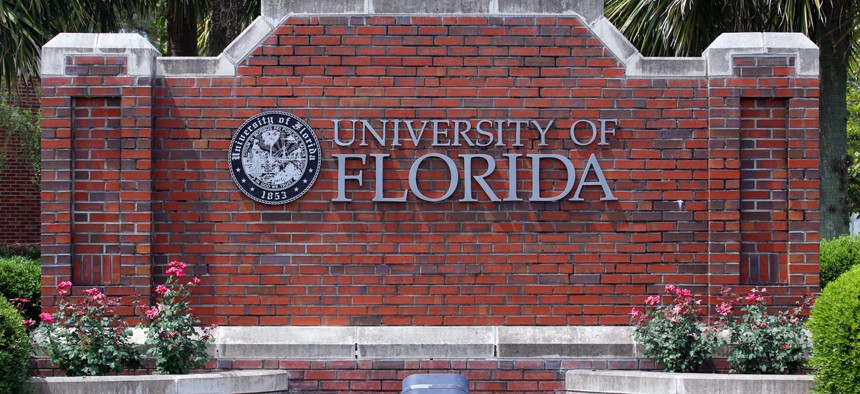Nvidia, University of Florida to Deliver ‘Fastest’ Academic Supercomputer by 2021

Katherine Welles/Shutterstock
Both aim to help strengthen the pipeline for America’s future tech workforce.
The University of Florida is poised to run the fastest artificial intelligence-rooted supercomputer in U.S. academia by early 2021 following millions in gifted funding provided by Nvidia, the two announced Tuesday.
AI-centric courses and concepts will be introduced across the university’s curriculum at-scale and shared with other students in the area as part of the effort—and insiders expect the collaboration to have federal implications, as well.
Collectively boosting the capacity of UF’s existing HiPerGator supercomputer, the entities plan to build and then deploy a system at the university later this year that can deliver 700 petaflops of performance, or 700 quadrillion floating point operations per second. The move was sparked by UF alumnus and Nvidia co-founder Chris Malachowsky, who offered up $25 million, which was subsequently matched by another $25 million from Nvidia for hardware, software, training and services. UF aims to provide another $20 million to produce an AI-focused supercomputing and data center, totaling the overall initiative at $70 million.
“Let me say that this really is a remarkable machine with ... enormous computing capacity, undoubtedly much larger than our faculty and students by themselves are capable of fully engaging. So we believe that not only is this a resource for the University of Florida, the state of Florida, and maybe even the southeast region, but we firmly believe that Nvidia and [Malachowsky] have brought us what should be a national resource,” UF’s Provost Joe Glover told Nextgov during a press briefing Monday. “So we will be having conversations with the federal government, first of all, about how they may wish to engage.”
On the call, Malachowsky reflected that he had reached a point in life where he’s ready to give back in a “significant way” and he set his sights on the university. After graduating from UF in 1980, he saw the potential for its wide domain expertise to address big-picture challenges such as rising tides and climate change, food security, transportation, personalized medicine and more—and the possibility to help enhance the region’s pipeline for tech-savvy personnel.
“As I kind of thought about all this, I had this ‘aha’ moment and realized that if we could give them the new tool of science, the new tool of discovery—an AI supercomputer of some significant performance levels—that all these problems could be addressed, the workforce could be upskilled, the region could benefit economically,” he explained. Malachowsky shared the idea with Nvidia CEO Jensen Huang, who he helped co-found the company with, and Huang agreed to match the investment dollar for dollar to “do something big.”
Backed by the investment, UF’s supercomputer will integrate an Nvidia superpod, which Malachowsky said integrates 140 DGX A100 systems powered by a combined 1,120 Nvidia A100 Tensor Core graphics processing units. The resource will also incorporate 4 petabytes of high-performance storage. Boasting almost 20 times more power in petaflops than the University of Texas at Austin’s Frontera—which was most recently deemed to be America’s top academic supercomputer—the system should rank among “the top 10 or so AI supercomputers in the world,” Malachowsky said. Several U.S. machines have made it to the Top 500 list of global supercomputers line up, though in June, Japan’s Fugaku topped America to take the number one spot.
During the call, Glover and Malachowsky highlighted how the initiative could palpably impact the federal landscape, as well.
“There's already been numerous conversations between different government agencies that all have the same focus, right, to ensure the competitiveness and capability of the nation juxtaposed against the rest of the world,” Malachowsky explained. “And this machine and the model that it represents, I think, is a potential solution—or something that could amplify all of their efforts.”
To strengthen America’s channel of prepared, tech-focused workers, the university plans to be one of the first in the country to integrate AI as a topic across all of it’s disciplines, and it’s also committed to hiring 100 new faculty members that are specifically focused on the evolving technology. UF will invite others to access and benefit from the tool and program, including those from historically Black and Hispanic-serving colleges, and K-12 programs. On top of partnering with other industry and academic groups, such as the Inclusive Engineering Consortium, the university also aims to stand up an “Equitable AI program,” through which faculty members can create standards to produce tools that are “cognizant of bias, unethical practice and legal and moral issues.
“We do believe that we are going to experiment with a model for training the next generation workforce that has competency and literacy in AI. We believe that this is a problem that the federal government has been very concerned with—there are a number of conditions and studies on AI and how quickly the nation is engaging with that technology—and so we expect also that there will be interested parties in Washington that will partner with us to help us train the next generation of AI enabled workers in this country,” UF’s Glover said. “So we think both on the scientific side, and on the workforce side, we have something to offer to Washington D.C. and the nation.”
Nvidia also intends to further promote the university’s pursuits by contributing its own AI expertise. Solution architects and product engineers from the company will partner with those on the ground to help optimize the school’s supercomputing assets. The newest Nvidia AI Technology Center will be launched on the campus to enable the chipmaker’s employees and UF’s graduate students to collaborate in hopes to advance the field—and the company’s Deep Learning Institute will also connect with university insiders to craft new, AI-centric coursework for students on the ground and across the community.
“I'm really hoping that this becomes a blueprint for public-private investment around the country,” Malachowsky said.






